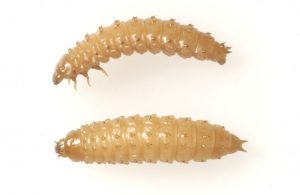The Small Hive Beetle (SHB), Aethina tumida, is an invasive species originating from Africa which has proved to be a serious pest of honeybee hives in the USA and Australia. The SHB has been made notifiable within the European Community (Commission Decision 2003/881/EC). The beetle can multiply to huge numbers within infested colonies, where it eats brood, honey and pollen, destroys combs and causes fermentation and spoiling of the honey. If beetle infestations are uncontrolled they ultimately destroy the colony.

Geographical Range
The Small hive beetle (SHB) is native to sub-Saharan Africa. In its native range it is a minor pest of weak honeybee colonies and stored honey supers. However, European bees have fewer natural defenses against SHB and consequently it has far greater harmful consequences. It was confirmed for the first time outside Africa in Florida USA, in May 1998, and since then has become widespread across the USA (in more than 30 US states and as far north as Minnesota). The beetle was later detected in New South Wales and Queensland in Australia in October 2002 and more recently in Canada (traced to imports of unrefined wax from Texas, USA). The beetle is also present in Mexico and Jamaica. It is as of April 2010 confirmed on the big island of Hawaii. Further details of these outbreaks can be seen on the OIE disease incidence reporting pages, World Animal Health Information Database (WAHID).
Of concern also is the fact that in October 2004 SHB larvae were identified in a consignment of queen bees imported into Portugal from Texas, demonstrating the potential for transport in this commodity.

Current Status
The small hive beetle is now confirmed present in Italy, but not so far elsewhere in Europe. On September 11 2014, the Italian Istituto Zooprofilattico Sperimentale delle Venezie, National Reference Laboratory for Apiculture (IZSV) confirmed the first detection of the presence of Small hive beetle (SHB) in South West Italy, in the port city of Gioia Tauro. A second outbreak was confirmed in Rosarno, approximately 1 km from the first infested apiary on September 17th 2014. In this outbreak, 4 colonies were found to be infested. Since then further infested apiaries have been confirmed.

Defra
Defra’s website includes a completed risk assessment on small hive beetle which can be found here
Defra have also completed a risk assessment on the potential for small hive beetle to be associated with produce and other plant products from Italy, click here
Work is ongoing to develop a lure for monitoring the Small Hive Beetle, see poster.
Further Information
More detailed information may be found in the NBU advisory leaflet The Small Hive Beetle – A serious new threat to European apiculture, the World Organisation for Animal Health OIE chapter on Small hive beetle or on the European Reference Laboratory’s (EURL) advisory leaflet.
The European Food Safety Authority (EFSA) has published an extensive report which details methodologies on SHB diagnostics, visual inspection in a colony and beetle mitigation through traps, chemical and husbandry methods is available here.
View a short video clip of Small Hive Beetle larvae and beetles in laboratory conditions.
For further information please see the 2010 article in Biologist: Small hive beetle, the next threat to British honey bees (pdf)
Adapted from BeeBase, National Bee Unit, Animal Health and Plant Agency (APHA) under the terms of the Open Government Licence (OGL). Crown Copyright.